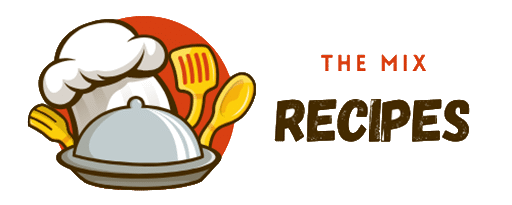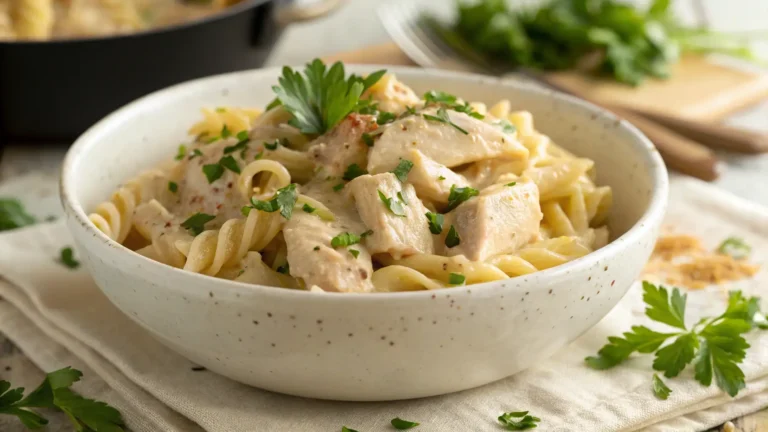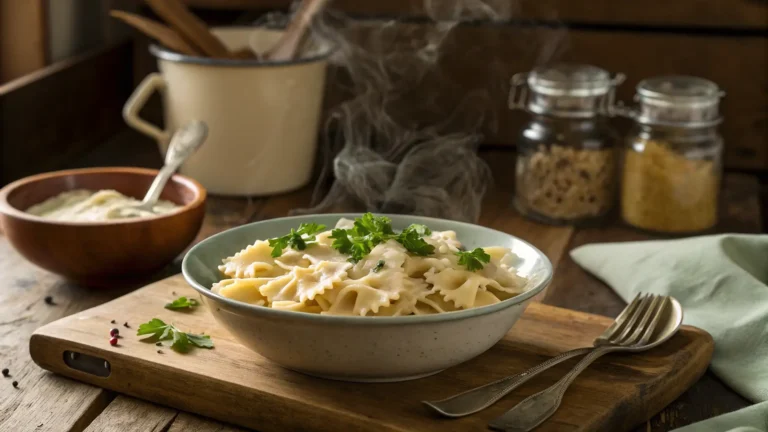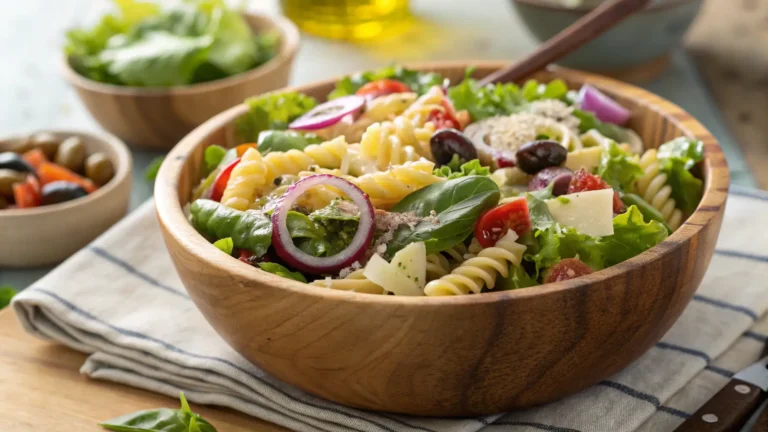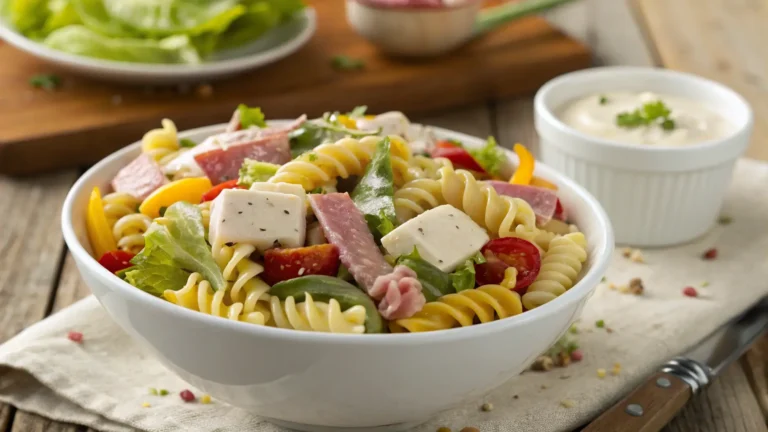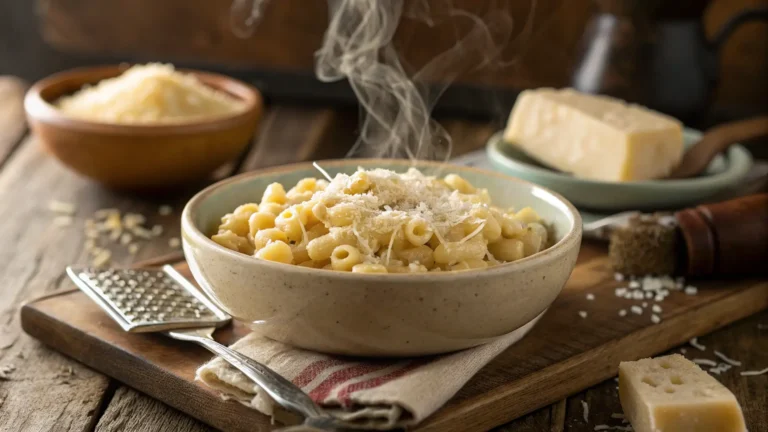Rasta Pasta Recipe – The Best Creamy Jamaican Pasta You’ll Ever Make!
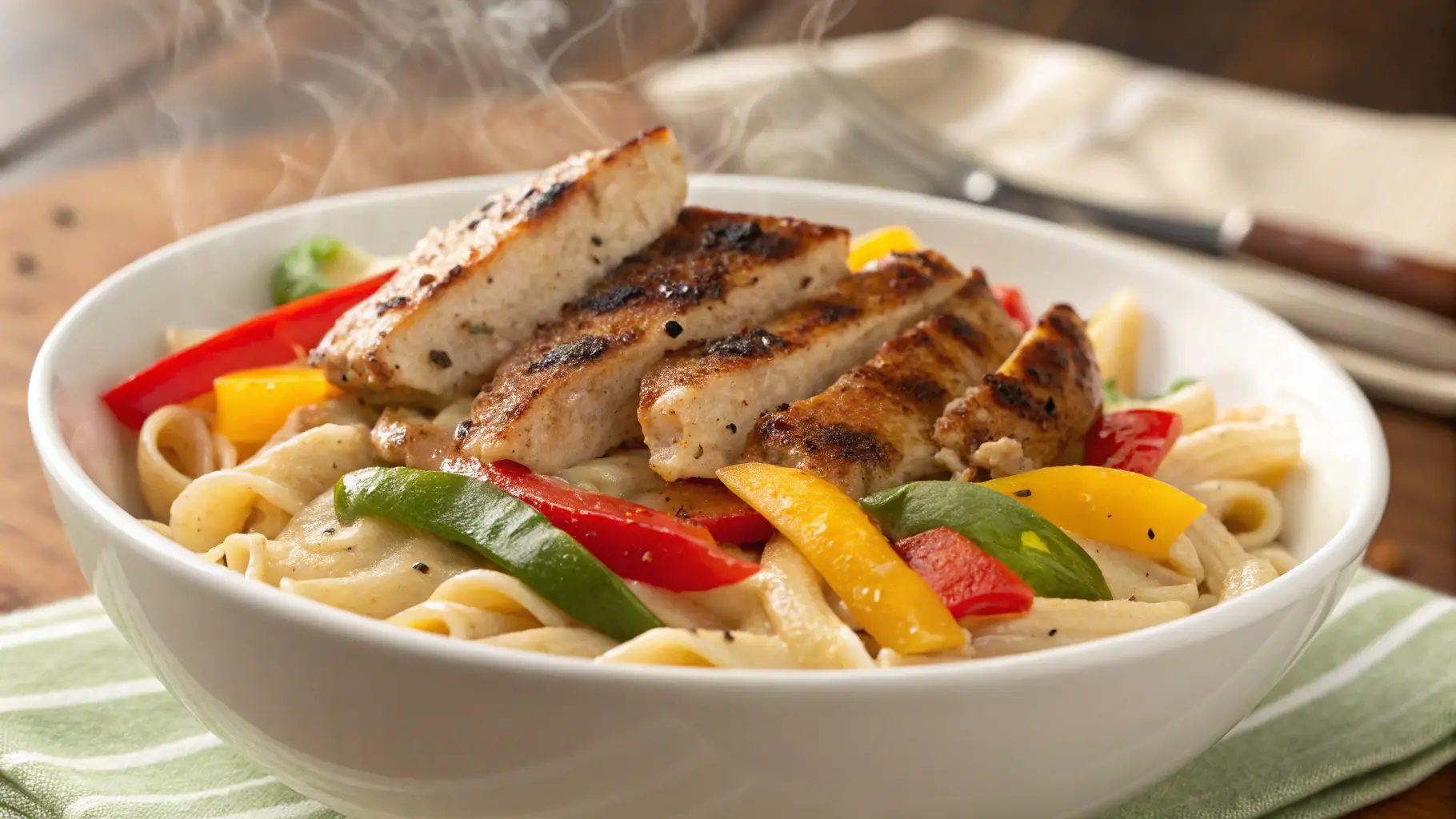
Table of Contents
A good rasta pasta recipe hits every note: creamy, spicy, savory, and colorful. Inspired by the bold and vibrant flavors of Jamaican cooking, this dish has grown into a cult favorite thanks to its comfort food feel and tropical flair. Whether you’re craving jerk-seasoned meats or simply want a cozy dinner with island vibes, this rasta pasta recipe gives you the perfect balance of heat and creaminess in one pot.
In this ultimate guide, we’ll walk you through how to make authentic Rasta pasta, what ingredients work best, and how to personalize your dish with vegan swaps, copycat Rainforest Café versions, and creamy sauce tips. By the end, you’ll have a complete go-to rasta pasta recipe that’s ready to wow your taste buds.
Check out our comforting twist on beef with the Ultimate Wagyu Ground Beef Recipe Guide for your next savory meal!
Let’s dive into the flavorful roots of this vibrant pasta dish.
What Is Rasta Pasta?
The Origin of Rasta Pasta: Caribbean Roots and Fusion
The rasta pasta recipe traces its flavorful legacy back to Jamaica, where fusion cooking reigns supreme. The dish was first introduced in the 1980s by Chef Lorraine Washington. She whipped up creamy pasta with colorful bell peppers for hungry Rastafarians working at her resort. The trio of red, green, and yellow peppers echoed the Rastafarian flag—earning the dish its iconic name: Rasta Pasta.
It may not strictly follow Ital (vegan) eating customs, but it proudly honors the cultural spirit behind them. It’s a celebration of Caribbean spice, soul, and simplicity in one creamy bowl.
Why It’s Called “Rasta Pasta” – Cultural and Flavor Significance
This colorful pasta isn’t just about looks—it packs a punch in flavor and meaning. The name “rasta pasta” comes from the dish’s Rastafarian-inspired color scheme and Caribbean roots. Today, the rasta pasta recipe has taken on many variations—from cheesy jerk chicken to fully plant-based versions using coconut milk and dairy-free cheese.
Its fusion of heat, cream, and vibrant color makes it a standout on any dinner table, whether served for guests or as a cozy solo treat.
Ingredients for an Authentic Rasta Pasta Recipe
Creating a flavorful rasta pasta recipe starts with choosing the right ingredients. The heart of this Caribbean-inspired dish lies in its bold spices, creamy sauce, and colorful vegetables. Here’s a breakdown of what you’ll need to bring your pasta to life.
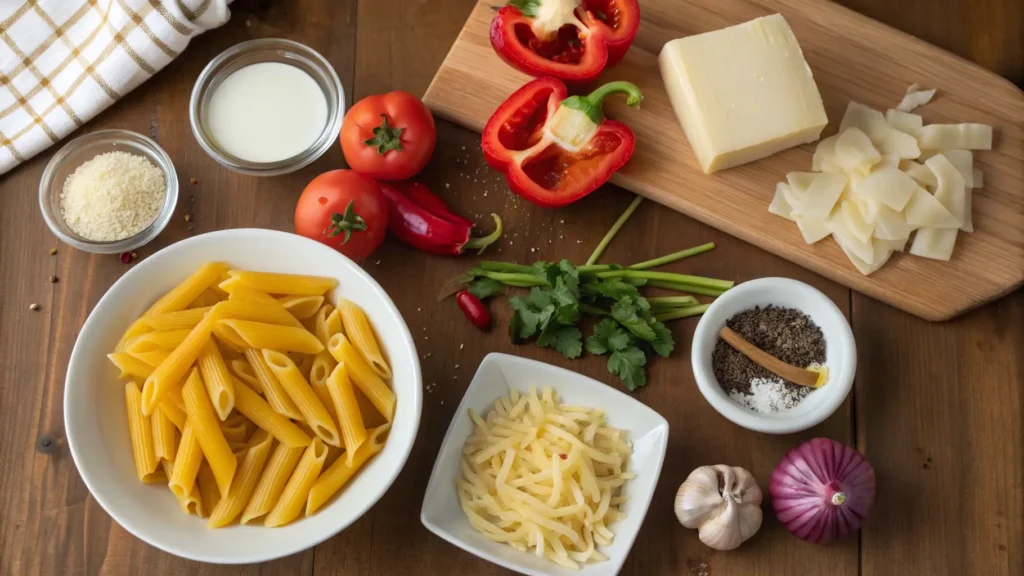
Main Components: Pasta, Veggies, Spices, Proteins
The beauty of this rasta pasta recipe lies in its flexibility. But there are some essentials that give it its signature look and taste:
| Ingredient Type | What to Use | Notes |
|---|---|---|
| Pasta | Penne, fettuccine, rotini | Holds sauce well; gluten-free options work too |
| Bell Peppers | Red, green, yellow | Echo Rastafarian colors and add crunch |
| Protein | Jerk chicken, shrimp, tofu | Add spicy depth or keep it vegetarian |
| Spices | Jerk seasoning, garlic, thyme | Key to the Jamaican flavor profile |
| Sauce Base | Heavy cream, coconut milk | Balances the spice with creamy richness |
| Cheese | Parmesan, mozzarella, cheddar | Melts into the sauce for velvety texture |
| Aromatics | Onion, scallions | Build foundational flavor |
| Oil/Butter | Olive oil, butter | For sautéing and richness |
Each of these ingredients contributes to the flavor harmony that makes rasta pasta so craveable.
Choosing the Right Pasta: Penne vs Rotini vs Fettuccine
The pasta isn’t just a carrier—it plays an active role in holding onto that thick, creamy sauce. Here’s how different types stack up:
- Penne: Most popular in any rasta pasta recipe because its hollow shape holds sauce inside.
- Fettuccine: Great for thicker sauces, especially if you’re going heavy on the cheese or cream.
- Rotini: Spirals are ideal for grabbing onto jerk seasoning bits and veggie pieces.
Ultimately, any pasta will do as long as it’s firm enough to hold the sauce without turning mushy. If you’re gluten-sensitive, opt for chickpea or rice pasta—but check the package to avoid overcooking.
Don’t miss our Best Smoked Fish Brine Recipe if you’re into bold, preserved flavor combinations.
Rasta Pasta Sauce – Creamy, Spicy & Irresistible
A bold, velvety sauce is the soul of every unforgettable rasta pasta recipe. It ties the heat, herbs, and cream together in one luscious bite. Whether you’re going classic with heavy cream or experimenting with dairy-free options, the secret lies in balancing spice and creaminess.
What Is Rasta Pasta Sauce Made Of?
At its core, rasta pasta sauce is a creamy blend with a kick—typically made from sautéed onions, garlic, bell peppers, jerk seasoning, and cream. Here’s a typical base for a rich and flavorful sauce:
- Jerk seasoning – the star of the show. You can use store-bought or make your own with allspice, thyme, paprika, cinnamon, garlic, and cayenne.
- Bell peppers and onions – sautéed until soft, they release sweetness that balances the heat.
- Garlic & scallions – deepen the aroma.
- Heavy cream or coconut milk – gives the sauce its silky, luscious texture.
- Grated cheese – usually parmesan or cheddar, melted in for richness.
- Chicken or veggie broth – optional, but adds depth.
- Butter or olive oil – used for the sauté base.
These elements melt together to create a silky, flavor-packed coating for your pasta.
Cream Options: Heavy Cream, Coconut Milk, or Cream Cheese?
Let’s break down the creamy contenders in your rasta pasta recipe:
Heavy Cream
- Pros: Classic, rich, stable when simmered.
- Best For: Traditional rasta pasta lovers who want thick, restaurant-style creaminess.
Coconut Milk
- Pros: Dairy-free, slightly sweet, tropical flavor.
- Best For: Vegan or dairy-free versions; enhances the Caribbean flair.
Cream Cheese
- Pros: Adds a tangy thickness, easy to melt into sauce.
- Best For: When you want ultra-rich, comfort-food-style sauce. Works well with chicken or shrimp.
If you’re wondering: Can coconut milk replace heavy cream in pasta? — absolutely! It gives a lighter, tropical twist and works beautifully in this recipe.
How to Make Rasta Pasta Step-by-Step
Making a rich, colorful, and flavorful rasta pasta recipe is easier than you might think. With a few well-timed steps and a handful of quality ingredients, you can pull off a dish that’s bold, creamy, and perfect for weeknight dinners or weekend gatherings.
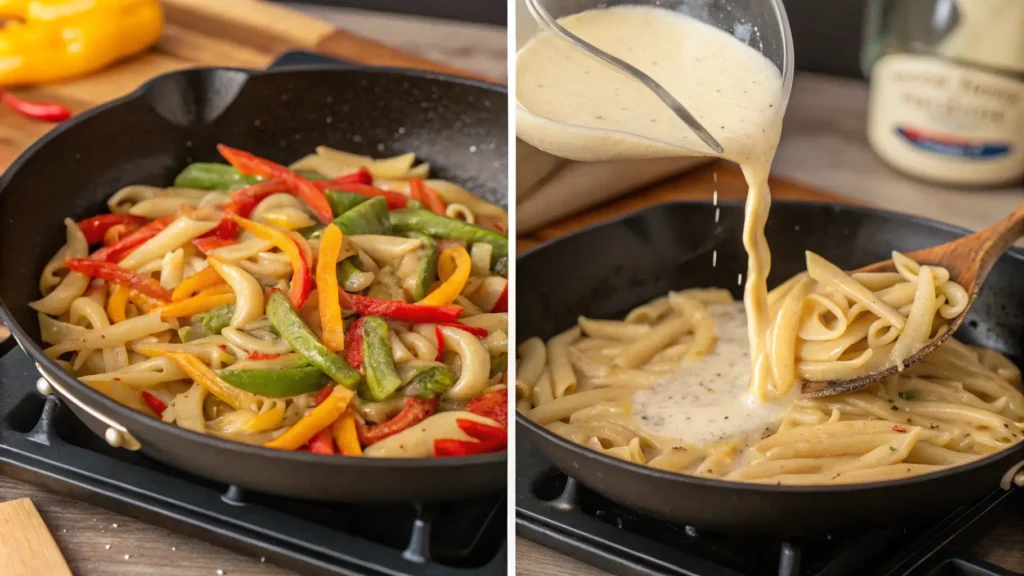
Here’s a complete walkthrough of how to make it at home—from prep to plate.
Prepping Ingredients: Chopping, Seasoning, Marinating
Prep is the secret to success in any creamy pasta dish—especially one this flavorful. Before you start cooking, get all your components ready:
- Chop: Slice red, yellow, and green bell peppers into strips. Dice onions and mince garlic.
- Marinate protein (if using): Coat chicken, shrimp, or tofu in jerk seasoning and let it sit for 15–30 minutes for deep flavor.
- Grate cheese: Fresh parmesan, mozzarella, or cheddar melts better than pre-shredded.
- Boil water: Salt your pasta water generously and cook your pasta until just shy of al dente—it’ll finish cooking in the sauce.
Organized prep makes everything come together quickly when the heat is on.
Cooking Process: Sauté, Simmer, and Combine Techniques
Once everything is ready, it’s go time. This is where your creamy rasta pasta recipe comes to life:
- Sauté veggies and aromatics
In a large skillet, heat olive oil or butter. Sauté onions and garlic until fragrant. Add bell peppers and cook until slightly soft but still colorful. - Cook protein
In a separate pan or the same skillet (after removing veggies), cook your marinated protein over medium heat until browned and cooked through. Remove and set aside. - Build the sauce
Add heavy cream (or coconut milk) to the skillet. Stir in jerk seasoning, a pinch of salt, black pepper, and grated cheese. Simmer for 3–4 minutes until thickened. - Add pasta and protein
Toss in your cooked pasta and protein. Stir everything together until the pasta is well coated and everything is heated through. - Finish & garnish
Adjust seasoning, add more cheese if needed, and top with chopped scallions or parsley for a fresh finish.
Optional: add a squeeze of lime juice for extra zing.
Customizing Your Rasta Pasta Recipe
One of the best things about this rasta pasta recipe is its adaptability. Whether you’re cooking for meat lovers, vegetarians, or those with dietary restrictions, you can easily tweak the ingredients without losing flavor or creaminess. Let’s explore how to customize it like a pro.
Protein Choices: Jerk Chicken, Shrimp, Tofu, or Beef
Protein is where you can get creative. The spicy cream sauce pairs well with a wide range of proteins. Here are your top options:
Jerk Chicken
The most popular and traditional choice. Use boneless, skinless chicken thighs or breasts, marinate them in jerk seasoning, and sear until perfectly charred. Slice and add to the pasta just before serving.
Shrimp
Shrimp cooks fast and absorbs seasoning quickly, making it an ideal option. Toss them in jerk spices and sauté for 2–3 minutes per side. Their slight sweetness complements the heat of the sauce beautifully.
Tofu
For a plant-based twist, extra-firm tofu works best. Press it, cube it, marinate, then pan-fry until golden. It’s a great way to keep your rasta pasta recipe dairy-free or vegan.
Ground or Stripped Beef
Not traditional but super hearty. Use lean ground beef or flank steak strips. Season, cook until browned, and fold in. This is a great way to bulk up the meal.
Looking for inspiration? Try our Ultimate Wagyu Ground Beef Recipe Guide for expert meat-cooking tips!
Dairy-Free and Vegan Adaptations
You can easily turn this creamy dish into a dairy-free dream with just a few swaps. Here’s how:
| Ingredient | Swap Option | Notes |
|---|---|---|
| Heavy cream | Full-fat coconut milk | Keeps it creamy and adds tropical flavor |
| Cheese | Vegan shredded cheese or nutritional yeast | Use brands that melt well for best results |
| Butter | Vegan margarine or olive oil | Maintains richness |
| Protein | Tofu, tempeh, chickpeas | Keeps it hearty and satisfying |
You can also skip the cheese entirely and thicken the sauce with a small amount of cornstarch or blended cashews for a smooth finish.
Common Mistakes to Avoid in Rasta Pasta
Even the best home chefs can make missteps with a rasta pasta recipe—especially with bold flavors and a creamy sauce involved. The good news? These common mistakes are easy to fix once you know what to look for.
Overcooking the Pasta or Curdling the Cream
Overcooking the Pasta
When your pasta is too soft, it doesn’t hold up well in a rich, creamy sauce. Instead, it becomes mushy and loses the signature bite that balances this dish.
Pro Tip: Always cook your pasta al dente (firm to the bite). Since it finishes cooking in the sauce, it’ll come out perfectly tender by the time you serve.
Curdling the Cream
If your cream or coconut milk splits or curdles, the sauce turns grainy instead of smooth. This often happens when it’s heated too fast or too long.
Fix It:
- Add cream slowly on low heat
- Never boil cream-based sauces
- Stir continuously while the sauce thickens
For coconut milk-based versions, full-fat options are less likely to curdle.
Balancing Spice, Creaminess, and Cheese Ratios
A truly satisfying rasta pasta recipe hits three major taste targets: heat, creaminess, and umami (cheesiness). Here’s how to stay in balance:
| Component | Common Mistake | Fix |
|---|---|---|
| Spice | Too much jerk seasoning burns or overpowers | Add in layers, taste as you go |
| Cream | Too little cream = dry pasta | Keep a 1:1 ratio of sauce to pasta by volume |
| Cheese | Too much can turn sauce gritty | Use grated cheese, add slowly, and stir until melted |
Also, make sure to use fresh, grated cheese instead of pre-shredded blends—they melt more smoothly and keep the sauce cohesive.
If your sauce gets too thick, a splash of pasta water or broth can loosen it while enhancing flavor.
Tips to Thicken and Enhance the Sauce
The sauce is the showstopper in any great rasta pasta recipe. If it’s too thin, it won’t cling to the noodles. If it’s too thick, it can feel heavy and clumpy. The trick is getting a velvety texture with layers of flavor that coat every bite.
How to Thicken Your Rasta Pasta Sauce
If your sauce is too runny, don’t panic. There are several easy fixes to thicken it without sacrificing taste or texture:
Use Pasta Water
Pasta water contains starch, which helps bind sauce and pasta. Reserve ½ cup before draining and stir it in gradually to smooth out and thicken the sauce.
Add Cheese Gradually
Cheese isn’t just for flavor—it’s also a thickener. Add shredded parmesan or cheddar slowly, stirring constantly. It melts evenly and gives the sauce body.
Simmer, Don’t Boil
Letting the sauce simmer on low heat allows liquid to reduce naturally and concentrate the flavor. Boiling can cause separation, especially with dairy.
Cornstarch Slurry
In dairy-free versions, a simple cornstarch slurry (1 tsp cornstarch + 2 tbsp water) works wonders. Stir it in and cook on low for a minute or two.
Cream Cheese Boost
Want a thicker, tangier cream? Stir in 2 tablespoons of cream cheese. It enhances richness and helps the sauce hug every noodle.
Flavor Boosters: Bouillon, Jerk Seasoning, Garlic Paste
Beyond thickness, your rasta pasta recipe should have flavor that jumps off the plate. If your sauce tastes bland, here are some additions that build serious depth:
| Booster | Why It Works | When to Add |
|---|---|---|
| Jerk Seasoning | Adds smoky spice | During simmer |
| Garlic Paste | Rich umami punch | With aromatics |
| Bouillon Cube or Base | Deepens sauce | Dissolve into cream |
| Lime Juice or Zest | Brightens richness | Right before serving |
Bonus Tip: A dash of nutritional yeast works great in vegan versions, adding a cheesy note without dairy.
Copycat Rainforest Cafe Rasta Pasta Version
If you’ve ever had the Rasta Pasta at Rainforest Cafe, you know it’s next-level—creamy, spicy, and loaded with flavor. Good news? You can recreate that same indulgent rasta pasta recipe at home with just a few strategic tweaks. This version leans into richness and restaurant-quality presentation.
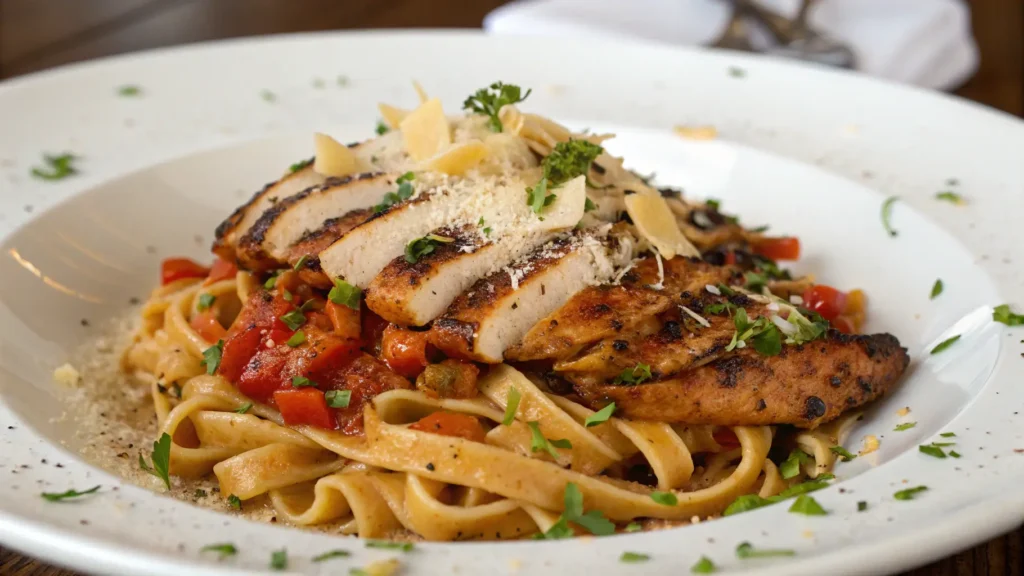
Ingredients and Prep for Restaurant-Style Results
To nail the Rainforest Cafe vibe, you’ll need:
| Ingredient | Notes |
|---|---|
| Penne pasta | Their go-to noodle—perfect for thick sauce |
| Jerk chicken | Heavily seasoned, grilled, and sliced |
| Bell peppers | Use all three: red, green, yellow |
| Heavy cream & cream cheese | Combo = ultra creamy texture |
| Garlic butter | Adds depth and richness |
| Shredded mozzarella & parmesan | Melt-in-your-mouth blend |
| Fresh basil or parsley | Garnish for freshness |
How to cook it like Rainforest Cafe:
- Grill your jerk chicken until lightly charred and juicy.
- In a skillet, melt garlic butter, then sauté peppers until tender.
- Stir in heavy cream, cream cheese, and shredded cheeses. Let it melt into a velvety sauce.
- Add cooked penne and toss to coat.
- Top with grilled chicken and garnish with fresh herbs and extra grated parmesan.
Want it spicy? Add a pinch of crushed red pepper or drizzle with hot sauce before serving.
This version is richer and cheesier than traditional Jamaican styles, but it still honors the bold flavors that make the rasta pasta recipe unforgettable.
Presentation Tips and Garnishing for a Wow Factor
It’s not just about flavor—presentation sells the experience. Here’s how to make your homemade version look restaurant-ready:
- Use a wide bowl or pasta plate to show off the colorful peppers and grilled chicken slices.
- Top with fresh parsley, scallions, or basil for a pop of green.
- Sprinkle extra cheese on top right before serving.
- Add lime wedges on the side for brightness and color.
This is the version you bring out when guests are over—or when you just want to treat yourself to something spectacular.
Serving, Storage & Reheating Tips
Once you’ve perfected your rasta pasta recipe, it’s time to serve it right—and save those leftovers for a second round of deliciousness. This section helps you make the most of your dish from presentation to reheating.
Best Side Dishes for Rasta Pasta
Rasta pasta is already rich and satisfying, but pairing it with the right side elevates your meal. Here are some go-to options:
| Side Dish | Why It Works |
|---|---|
| Fried plantains | Sweetness balances spice |
| Jamaican rice and peas | Traditional, hearty, and mild |
| Garlic bread | Perfect for soaking up extra sauce |
| Steamed vegetables | Adds freshness and crunch |
| Simple side salad | A refreshing contrast to the creaminess |
Want to turn this rasta pasta recipe into a showstopper dinner? Plate it family-style with plantains, salad, and a glass of chilled coconut water or mango juice.
How to Store and Reheat While Maintaining Texture
Proper storage is key to keeping that creamy texture intact. Here’s how to save and revive your rasta pasta recipe without turning it into mush:
Storage:
- Let the pasta cool completely before transferring it to airtight containers.
- Store in the fridge for up to 3 days.
- Freeze portions (without cheese topping) for up to 2 months if needed.
Reheating:
- Stovetop (Best Option): Add a splash of milk or cream to a pan and gently heat the pasta, stirring until smooth.
- Microwave: Use medium heat in short bursts (30–45 seconds), stirring between rounds and adding a little cream if the sauce looks dry.
- Oven: Place pasta in a baking dish, cover with foil, and bake at 350°F for 10–15 minutes until hot.
Pro Tip: If frozen, thaw in the fridge overnight before reheating.
This creamy rasta pasta recipe reheats beautifully if you follow these steps—and may even taste better the next day once the flavors have settled.
Conclusion: Make This Rasta Pasta Recipe Your Own
Whether you’re cooking up a spicy dinner for friends or meal-prepping creamy leftovers for the week, this rasta pasta recipe delivers big flavor, bold color, and a whole lot of comfort. Its creamy jerk-infused sauce, vibrant bell peppers, and customizable proteins make it a flexible favorite in kitchens everywhere.
Now that you know how to make it from scratch, adapt it to your taste—go dairy-free, add extra spice, or try a Rainforest Cafe-style twist. No matter your spin, this dish guarantees flavor in every forkful.
Don’t miss our other reader favorites like the Best Smoked Fish Brine Recipe—perfect for flavor lovers who want to explore beyond pasta.
FAQs – Frequently Asked Questions About Rasta Pasta
What is Rasta pasta sauce made of?
Rasta pasta sauce is typically made with a creamy base—usually heavy cream or coconut milk—combined with jerk seasoning, garlic, onions, bell peppers, and cheese. This bold, spicy sauce defines the rasta pasta recipe and gives it its signature Caribbean flavor.
What cream do you use in Rasta pasta?
Most classic versions of the rasta pasta recipe use heavy cream for richness and stability. However, you can also use half-and-half, evaporated milk, or coconut milk depending on your dietary preferences.
Do you put coconut milk in Rasta pasta?
Yes, coconut milk is a popular alternative to dairy in many Rasta pasta variations. It’s ideal for a vegan or dairy-free rasta pasta recipe, and adds a subtle tropical flavor that complements the heat of the jerk seasoning.
What kind of cheese goes into Rasta pasta?
Parmesan, mozzarella, cheddar, or a mix of all three are commonly used. In Rainforest Cafe–style rasta pasta recipes, a blend of mozzarella and parmesan gives it a gooey, creamy finish.
What is the best cream to add to pasta?
Heavy cream is best for thickness and consistency. For a lighter version, coconut milk or a bit of cream cheese mixed with broth can also work beautifully in your rasta pasta recipe.
Can I put cream cheese in Rasta pasta?
Absolutely. Cream cheese not only thickens the sauce but adds a tangy richness. It’s a great addition if you’re looking to upgrade the texture of your rasta pasta recipe.
How do I thicken my Rasta pasta sauce?
To thicken your sauce, simmer it gently, add cheese slowly, or stir in a cornstarch slurry. Another trick is to reserve and use starchy pasta water. These methods help build a creamy, clingy texture that coats every bite of your rasta pasta recipe.
Can coconut milk replace heavy cream in pasta?
Yes! Full-fat coconut milk is a fantastic dairy-free replacement for heavy cream in a rasta pasta recipe. It keeps the dish creamy while adding a subtle coconut note that fits perfectly with Caribbean flavors.
How to make Rainforest Cafe Rasta Pasta?
To mimic the restaurant’s version, use grilled jerk chicken, garlic butter, mozzarella, cream cheese, and penne pasta. Finish with a garnish of fresh parsley or basil. Our guide in Part 8 walks you through the full rasta pasta recipe Rainforest Cafe–style.
What noodles are best for Rasta pasta?
Penne is the most popular choice—it holds sauce well and has a great bite. You can also use rotini, rigatoni, or even fettuccine depending on your preference. The key is picking a noodle that won’t fall apart in your creamy rasta pasta recipe.
Have you given our recipe a try?
There are no reviews yet. Be the first one to write one.
